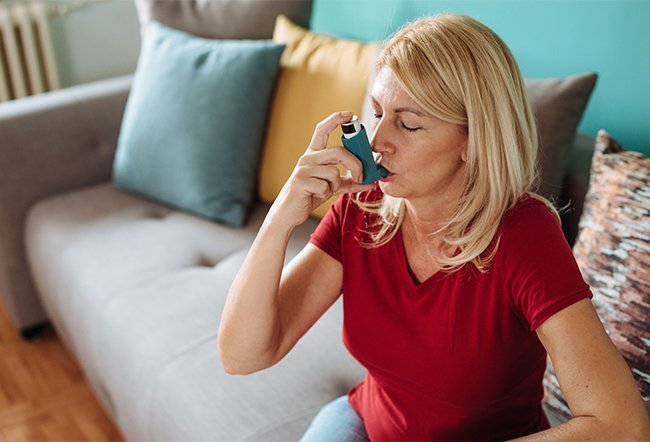What Is the Main Cause of Bronchial Asthma?

The main cause of bronchial asthma is genetic makeup interacting with environmental triggers which produce symptoms such as severe attacks that can only be treated with short-lived relief that does not prevent a recurrence.
The main cause of bronchial asthma is from complex interactions between an individual's inherited genetic makeup and their interactions with the environment. Hence, the causes can be divided into two types.
- Inducing factors
- Triggering factors
- Inhalation of allergens: House dust, pollen, mold, animal dander.
- Environment: Cold and dry climate, cooking gas fumes, passive cigarette smoking, paints and sprays.
- Infections: Upper respiratory tract infections, viral infections.
- Drugs: Aspirin, painkillers (NSAIDs).
- Food: Coloring agents of food, food preservatives, ice creams.
- Exercise: Vigorous exercise particularly on a cold and dry day.
- Psychological factor: Stress and anxiety.
- Occupation: Wood and cotton dust, chemicals.
Bronchial asthma may be induced by various stressors. Psychosocial stressors work through the central nervous system as an inducing factor and cause disorders in the autonomic nervous system, endocrine system and immune system. The disease tends to become serious and difficult to cure unless the stressors are dealt with properly.
What are the signs and symptoms of bronchial asthma?
Bronchial asthma is a severe inflammatory disease of the airway, with symptoms differing between people. Some people might experience the attacks always, frequently, only at certain times, or during some activities.
A few common signs and symptoms of bronchial asthma are:
- Breathlessness along with forcible exhalation
- Cough
- Wheezing or whistling sounds while breathing
- Tightness of chest
- Thick mucus sputum
- Aggravation of symptoms during the night and early morning
- Fainting after severe respiratory distress or severe breathlessness
- Difficulty sleeping because of breathing problems
- Increased discomfort in lying position
The symptoms of bronchial asthma may start with mild wheezing and later progress to severe life-threatening situations. Typically, attacks start late at night or early morning, presenting with breathing difficulty, restlessness, wheezing and a severe cough. The coughing may be associated with mucoid expectoration. The attack usually subsides within a few hours.
Patients usually adopt an upright position to make breathing easier. Most often the cold or a cough aggravates the breathing distress, which may also be associated with an increased heart rate, sweating, and, at times, cyanosis (bluish discoloration of the skin). Many people have reported that symptoms worsen after doing physical activities or exercise.
What are the treatment options for bronchial asthma?
Since bronchial asthma is a chronic condition, it usually requires continuous medical care. Doctors prescribe medications and lifestyle changes to treat asthma. It is best to identify the triggers to avoid and eliminate potential exposure. If avoidance of triggers is insufficient or not feasible, then medicine use is recommended. Currently, available important anti-asthma drugs can be classified as:
- Controllers (required for the maintenance of treatment)
- Relievers (required for quick relief, rescue drugs)
Controllers (prophylactic, preventive, and maintenance)
Taken daily to keep asthma under control.
- Steroids
- Long-acting beta-2 agonists
- Sustained release theophylline
- Leukotriene receptor antagonists
- Cromones
Relievers (quick relief, rescue)
Rapid-acting drugs that relieve bronchoconstriction.
- Short-acting beta-2 agonists
- Anticholinergics
- Theophylline
- Short-course oral steroids
- For immediate treatment, bronchodilators (medications that widen the airways, such as beta-2 agonists) are used, which are usually administered by inhalation.
Making lifestyle changes can also help control asthma symptoms. For instance, limiting smoking and reducing exposure to secondhand smoke can help curb symptoms. Measures to control dust mites, such as using air filters and vacuuming, can also help. Exercise is recommended for people with stable asthma. In fact, yoga can be a measure to help provide a better quality of life and improve symptoms in asthma sufferers.
Despite remarkable advancements in the diagnosis and management of diseases, effective therapeutic intervention for permanent asthma relief is still elusive in most medical treatment modes. Treatments offered usually cater to only short-lived relief and do not prevent a recurrence.

